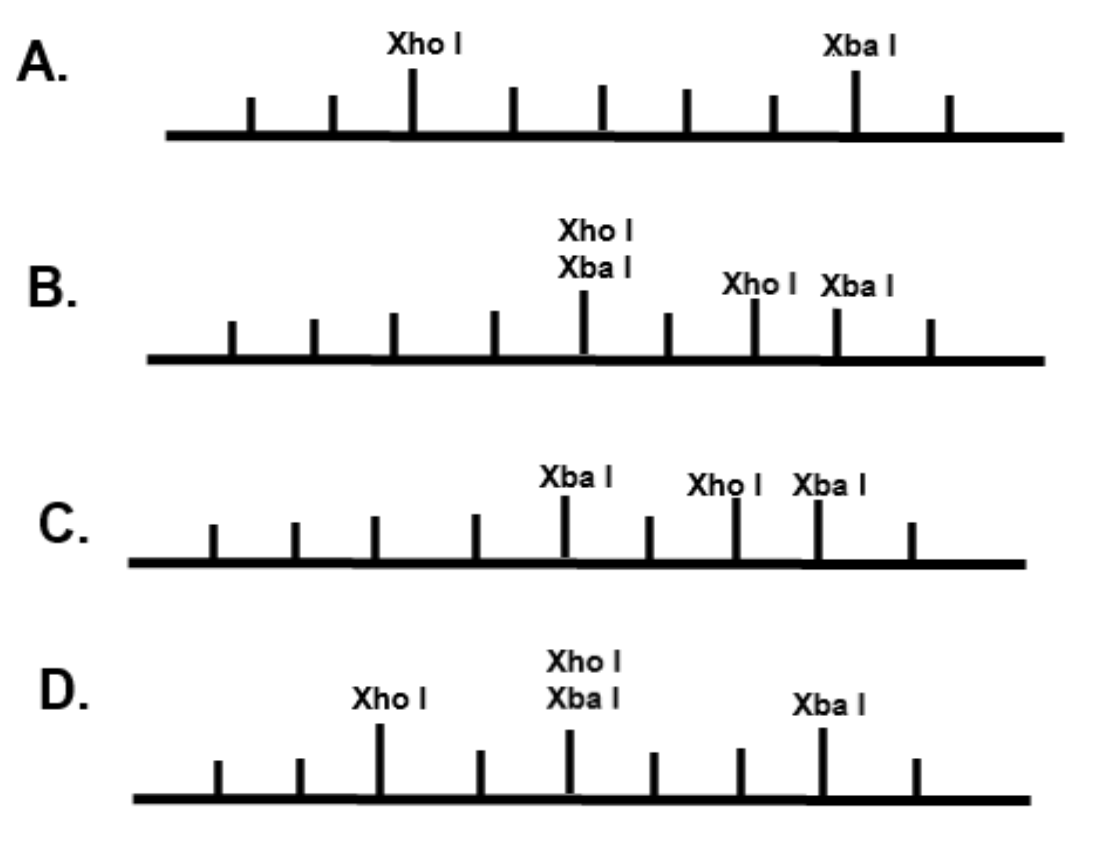
The restriction enzyme XhoI and XbaI were used to digest a linear fragment of DNA at a specific sequence such as that shown for EcoR1 (figure above). Use the information gained from the resolution of the fragments by gel electrophoresis to determine which of the following restriction maps best fits the data.




Answer
577.8k+ views
Hint: Restriction endonuclease is the enzyme that cut the DNA at specific sequence into fragments at or near the restriction sites. They are used for mapping of DNA.
Complete Answer:
- Restriction enzymes are found in bacteria. These are the classes of endonucleases which cut the DNA at specific sequences. They are also known as molecular scissors. Each restriction enzyme recognises specific sequences which are specific to certain DNA strands.
- Once the restriction enzyme is administered, the DNA strand is cut at a specific site which leads to several smaller DNA fragments. Then it is run on the gel electrophoresis. All the fragments separate as per the molecular weight. The heavier fragments travel a shorter distance than the smaller fragment.
- When restriction enzymes XhoI and Xba I are administered, it will cut the DNA at sites specific to these two enzymes. Thus 3 fragments will be formed. The molecular weights of the fragments are 200 (Xba1), 300 (XhoI) and 500 (XbaI + Xho1) (according to the given figure).

In option B, C, D two restriction enzymes cannot cut the same sequence of DNA, yielding similar molecular weight fragments.
Thus the correct answer is A. Three fragments are obtained.
Note: Restriction endonucleases are specific to a particular DNA segment. They cleave the DNA at a particular site. On gel electrophoresis, DNA fragments are separated on the basis of size. The lower molecular weight fragment will be found at the end of the gel as it will move faster and farther in a gel. The reverse applies for the heavier fragment.
Complete Answer:
- Restriction enzymes are found in bacteria. These are the classes of endonucleases which cut the DNA at specific sequences. They are also known as molecular scissors. Each restriction enzyme recognises specific sequences which are specific to certain DNA strands.
- Once the restriction enzyme is administered, the DNA strand is cut at a specific site which leads to several smaller DNA fragments. Then it is run on the gel electrophoresis. All the fragments separate as per the molecular weight. The heavier fragments travel a shorter distance than the smaller fragment.
- When restriction enzymes XhoI and Xba I are administered, it will cut the DNA at sites specific to these two enzymes. Thus 3 fragments will be formed. The molecular weights of the fragments are 200 (Xba1), 300 (XhoI) and 500 (XbaI + Xho1) (according to the given figure).

In option B, C, D two restriction enzymes cannot cut the same sequence of DNA, yielding similar molecular weight fragments.
Thus the correct answer is A. Three fragments are obtained.
Note: Restriction endonucleases are specific to a particular DNA segment. They cleave the DNA at a particular site. On gel electrophoresis, DNA fragments are separated on the basis of size. The lower molecular weight fragment will be found at the end of the gel as it will move faster and farther in a gel. The reverse applies for the heavier fragment.
Recently Updated Pages
A man running at a speed 5 ms is viewed in the side class 12 physics CBSE

State and explain Hardy Weinbergs Principle class 12 biology CBSE

Which of the following statements is wrong a Amnion class 12 biology CBSE

Two Planoconcave lenses 1 and 2 of glass of refractive class 12 physics CBSE

The compound 2 methyl 2 butene on reaction with NaIO4 class 12 chemistry CBSE

Bacterial cell wall is made up of A Cellulose B Hemicellulose class 12 biology CBSE

Trending doubts
What are the major means of transport Explain each class 12 social science CBSE

Which are the Top 10 Largest Countries of the World?

Draw a labelled sketch of the human eye class 12 physics CBSE

State the principle of an ac generator and explain class 12 physics CBSE

Sketch the electric field lines in case of an electric class 12 physics CBSE

Give 10 examples of unisexual and bisexual flowers




